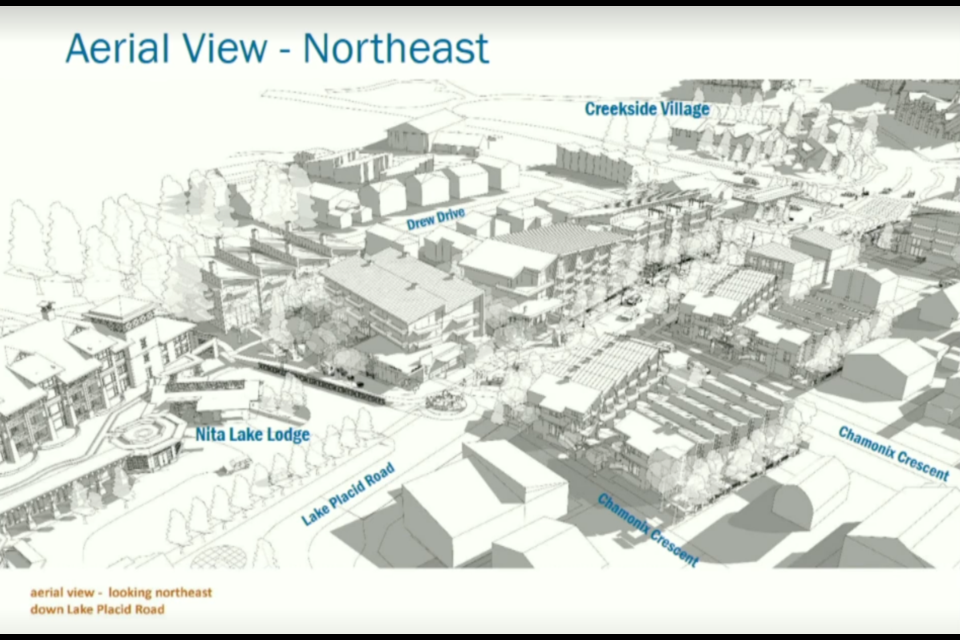Whistler’s mayor and council got a look at how new provincial housing legislation—namely, Bill 44—may impact local neighbourhoods this week.
The Lake Placid Road Neighbourhood Study is not a set of development proposals, or even a plan, explained general manager of climate action, planning and development services Dale Mikkelsen at the April 23 committee of the whole.
Like the name says, it is simply a study.
“We’re looking forward to a conversation around this study and the ideas that it brings up ... and to seek that input and discuss what the next steps might be coming out of this study,” Mikkelsen said.
Bill 44 is part of a suite of new provincial housing laws designed to increase affordable housing stock in the province. It aims to make it easier for developers to create small-scale, multi-unit homes fitting in existing neighbourhoods.
At the Resort Municipality of Whistler (RMOW), staff want to ensure they’re not missing opportunities in neighbourhoods with significant single-family zoning under the Official Community Plan (OCP), Mikkelsen said.
“Lake Placid Road is an area in Creekside that the OCP has spoken to as an area for enrichment, densification and increasing vitality,” he said.
“This study is looking at how we may do that, and to create that framework for discussion and possibly potential for instruction for carrying on to part of the design detail and/or rezoning or site-area rezoning for this neighbourhood.”
Mock-ups shared with council envision a wildly reimagined space along the Creekside road, transforming unkempt dirt lot frontages into welcoming, pedestrian thoroughfares; building higher-density apartment buildings; and reconfiguring the busy Highway 99 pedestrian crossing.
The new study builds off a comprehensive area study completed all the way back in 1991.
“This area is already designated as Core Commercial in our OCP, and offers also an excellent opportunity for revitalization, given its existing built environment and its proximity to various landmarks and roads such as Creekside Village, the railway station, and the Valley Trail,” said planner Louis-Felix Renaud-Tremblay, in explaining why Lake Placid Road was chosen for the study.
“The street currently lacks pedestrian infrastructure with ample street parking and sidewalks only on one side,” he said. “Additionally, there appears to be a potential desire among homeowners to increase the density of their property, emphasizing the importance of capitalizing on this opportunity effectively now.”
Intentional upzoning for increased density is often regarded as a best practise, Renaud-Tremblay said.
“It focuses densification in a place where it can handle it, and the strategy could lead to a more cohesive urban and built environment by incentivizing redevelopment and additional land consolidation in the area,” he said.
“This initiative could help revitalize vacant sites and improve [or] upgrade areas, transforming them into vibrant community hubs and leveraging opportunities for additional density that could provide more employee housing for our community.”
Further, since Creekside also serves as Whistler’s southern entrance, “developing a neighbourhood plan could also help define a neighbourhood character for the area and welcome visitors to our town,” he added.
During discussion, Councillor Cathy Jewett noted the reduced street frontages in the designs, wondering if there is enough right-of-way for the municipality to maintain two lanes of traffic in addition to sidewalks.
“Everything that you’re looking at here was done within existing property lines and within existing road right of ways, so we’ve amended none of the legal boundaries that you’re looking at today,” Mikkelsen said. “[We wanted] to show that within existing legal boundaries this plan could be implemented.”
Council voiced general enthusiasm for the study and its concepts, though Jewett said she hopes Creekside’s original Whistler charm isn’t discounted through the process.
“When I first got here, back in the olden days, when there was no village, this was the village,” she said. “I hope that there will be some reference to that in the design thought, because looking at this I see it kind of losing a bit of that.”
Mayor Jack Crompton appreciated that sentiment, but also said he wants to drive density in the area.
“I hear the idea about the concern about streetscape and holding tight to what Creekside has been, [but] I think a little bit about Banff and how they do have multi-storey buildings with rooftop gardens and patios, and it feels very culturally Banff, but they are big, big buildings,” he said.
“And so I’m excited about the idea of this maintaining its Creekside vibe, but really providing opportunities for people to live near the base of the hill, and I love the idea about density bonusing for resident employees.
“I think this would be one of the best places to live in Whistler.”
Council will hear more about the study and any potential redevelopment plans at an upcoming meeting. Watch the April 23 committee of the whole presentation in full at whistler.ca.




